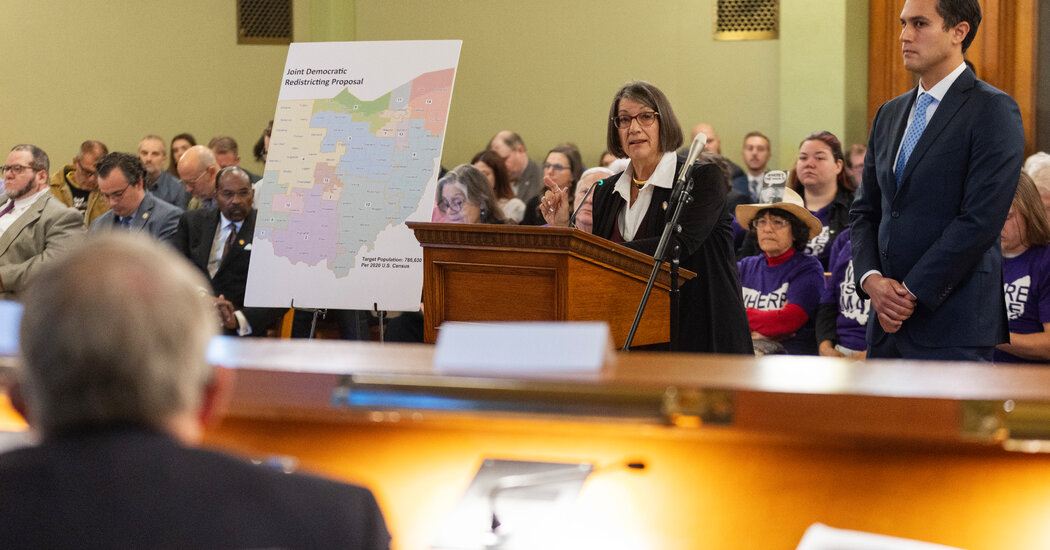Ohio on Friday became the latest Republican-led state to redraw its congressional map to boost the party’s chances of keeping control of the House of Representative in next year’s midterm elections.
The map was approved at a morning meeting of the state’s redistricting commission, and will give Republicans, who currently hold 10 of Ohio’s 15 seats in Congress, a total of 12 districts that lean red.
With Republicans in control of Congress by just a few seats, President Trump has been urging allies in state capitals to redraw congressional maps earlier than normal to try to diminish Democrats’ chances of flipping the House.
Texas, North Carolina and Missouri had already passed new maps, while the State Legislature in Indiana will hold a special session for redistricting next week, all of them acting at the president’s behest.
In Virginia, Democrats in the state legislators on Friday advanced a constitutional amendment that if it clears additional hurdles in the coming months, would allow Democrats to redraw the congressional maps to shift up to three districts to their favor. In California, voters are likely to approve maps next week that could flip five seats for Democrats in 2026, polls show. And in Illinois, Democrats also have begun efforts to redraw maps.
The new map for Ohio publicly emerged only late this week, when it was presented at a hastily called meeting of the state’s redistricting commission meeting on Thursday in Columbus. For weeks, the seven-member commission had taken no public action and it appeared that the task of redrawing the maps would end up back with the State Legislature, where Republicans hold a super majority.
More than a dozen speakers excoriated both Republicans and Democrats for backroom dealing that produced a map they considered rigged.
“You are like foxes guarding the hen houses and Ohio voters continue to be the hens,” said Michael Ahern, who spoke to the commission on Thursday wearing a baseball cap bearing the first three words of the Constitution, “We The People.”
On Friday, with people turning out again to decry the process, the commission reconvened, and the two Democrats on the commission — Nickie Antonio, the Senate minority leader, and Dani Isaacsohn, the House minority leader joined the five Republicans in backing the new map. No members of the commission explained why they voted for the map.
The map improves Republicans’ odds of picking up two more seats, though not the three they had set out to capture. It redraws three Democrat-held districts, near Toledo, Akron and Cincinnati.
Marcy Kaptur, a Democrat who is the longest-serving woman in Congress, has survived redistricting twice before, including last November when she won by fewer than 2,400 votes (less than 1 percent). Her Toledo-area district was won by Mr. Trump by seven points, while the new district went for Mr. Trump by 10 ½ points.
Emilia Sykes, a Democrat near Akron, may be securing something of a buffer, with more registered Democrats being drawn into the district that she won last year by a margin of 51 percent to 49 percent. Ms. Sykes is the daughter of a retired legislator, Vernon Sykes, who coauthored the 2018 anti-gerrymandering measure.
The other seat being redrawn is held by Greg Landsman, whose district includes Cincinnati. The district will have a nearly 8-point swing with additional Republican voters, though Democrats have generally performed well.
Ms. Kaptur, 79, affirmed that she will still run for re-election, saying in a statement that “our democracy works best when voters choose their leaders, not when politicians choose their voters. Let the Columbus politicians make their self-serving maps and play musical chairs. I will fight on for the people and ask the voters for their support next year.”
The Republicans could have pushed a more aggressively redrawn map through the Legislature. But the new maps carry a bipartisan stamp that could insulate Republicans from court challenges and neutralize criticism that Democrats might have raised in statewide elections for governor and the U.S. senate next year.
Unlike many of the states pursuing new maps ahead of the normal, once-a-decade schedule, Ohio did not have a choice. Its Constitution requires state lawmakers to enact a new map because the current one, drawn in 2021 after the most recent census, did not have bipartisan backing and so was valid for only four years, instead of the 10 it would have been with bipartisan support.
Efforts to curb partisan redistricting, known as gerrymandering, have been ongoing in Ohio for a decade, most notably in 2018 when a ballot measure with bipartisan support passed with 71 percent of the vote.
But the state, once competitive and consequential in presidential elections, has turned solidly red in recent years. Republicans control the Legislature and the State Supreme Court and hold the governor’s office, along with both U.S. Senate seats and the majority of House seats. It has also become a cradle of vocal Trump allies, such as Vice President JD Vance, Representative Jim Jordan and Senator Bernie Moreno.
In recent years, Republicans have made annual efforts to stack the map in their favor — plowing past requirements that ban partisan mapmaking and ignoring unfavorable court rulings. In a state that Mr. Trump carried with 55 percent of the vote, Republicans control 73 percent of the State Senate and 66 percent of the House.
“The Republican Party is more powerful than it is popular,” said David Niven, a professor at the University of Cincinnati’s School of Public and International Affairs who has studied redistricting.
The post Ohio Republicans Push Through New Districts in Bid for More Seats in Congress appeared first on New York Times.




